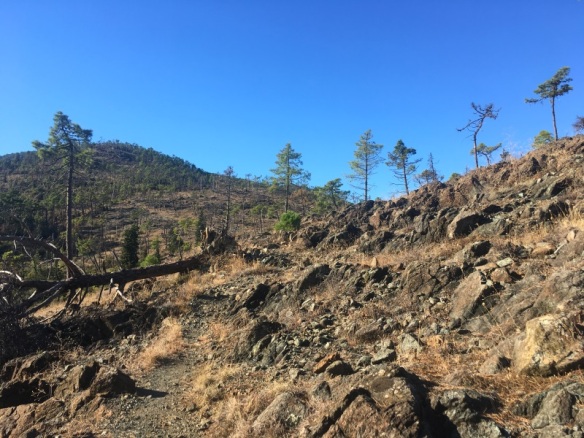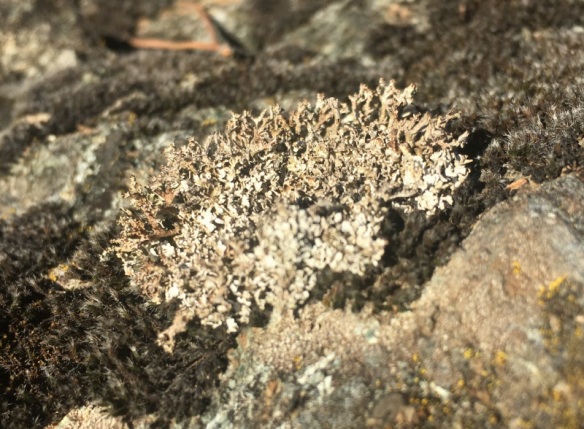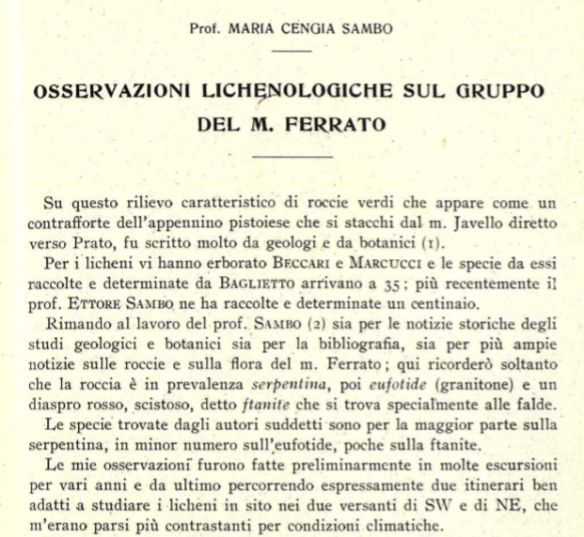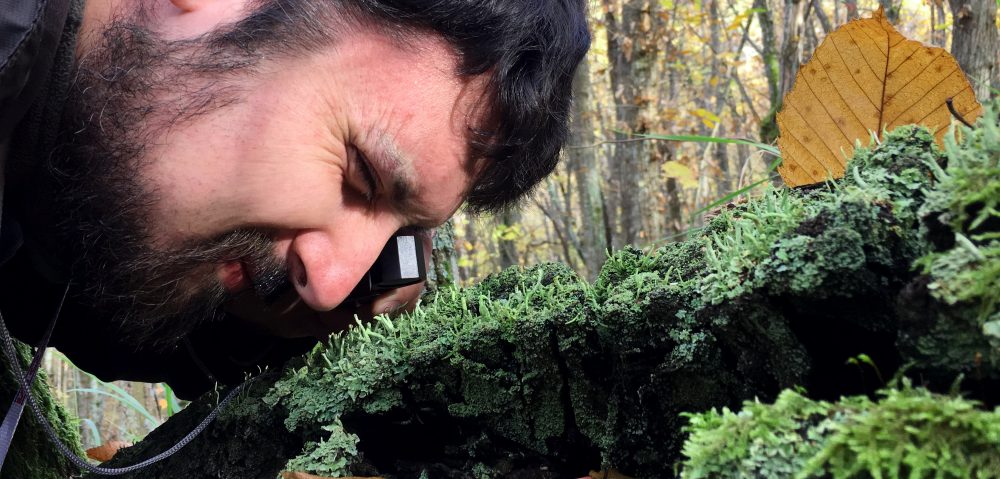In conclusion of the XXXI meeting of the Italian Lichen Society in Pistoia (Tuscany), in September 2018, I took part to the final excursion which took place at Monte Ferrato, a huge ophiolite outcrop located in the outskirts of the city of Prato.

Ophiolite is a very interesting substrate for lichens (see the review by Favero-Longo et al. 2004), and I was curious to check which Cladonias would occur there, after having developed in the past years some knowledge on the Cladonias of the ophiolite outcrops of the province of Pavia (Lombardy).
The other peculiarity of the site chosen for the excursion was that the area had been investigated 80-90 years ago by the spouses Ettore Sambo (1884-1971) and Maria Cengia Sambo (1888-1939), who lived in Prato. Maria Cengia Sambo in particular is remembered as one of the few Italian lichenologists between the “Golden Age of Italian lichenology” (from the 1840s to the 1910s) and the “Reinassance of Italian lichenology” (from the late 1980s). However, her skills in identifying lichens are still controversial, and some of her identifications are considered unreliable – especially in some cases in which she proposed new taxa.
Both the Sambos investigated lichens on Monte Ferrato: Sambo (1927) under a floristic perspective, Cengia Sambo (1937) considering also the ecology of the lichens on the ultramafic substrate and the morpho-physiological modifications caused by it (e.g. “stenophyllous forms”, thalli with underdeveloped lobes due to the harsh conditions found on ophiolite substrates).
Overall, in their 2 papers (Sambo 1927; Cengia Sambo 1937) the Sambos reported 21 Cladonia taxa (Appendix 1), whereas during the SLI excursion on M. Ferrato I managed to find only 4 terricolous species (Appendix 3), which are more or less the same ones I collected on the ophiolites of the Lombardy Apennine – perhaps there is also a fifth species, but its primary thallus is so underdeveloped (or just young) that I wasn’t able to identify it.
Even if we investigated only a small area, and therefore we could have missed some species (since the Sambos explored a very larger extent of Monte Ferrato and neighbouring hills), some considerations can be done, especially in the light of the misidentifications of Cladonia specimens carried out by the Sambos (Appendix 2).

The first thing emerging from the two papers by the Sambos, about Cladonia, is a nomenclatural and taxonomic mess. For example, C. muricata, C. pungens and C. rangiformis are listed as different species, while nowadays they are all recognized just as synonyms of C. rangiformis; the same is for C. alcicornis and C. endiviaefolia, which both indicate C. convoluta – which has recently been synonymized with C. foliacea (Appendix 1).
The other problem is of biogeographical nature: the records of strictly (sub)alpine species such as C. amaurocraea, C. phyllophora, C. stellaris, C. uncialis, were already considered very dubious by Nimis (1993), and seemed very unlikely also to me. In spite of what stated by Cengia-Sambo about the “alpine species came down from the Alps unto Monte Ferrato”, environmental and climatic conditions were probably unadequate to those species also a century ago, and according to Occam’s Razor an erroneous identification is the most reliable explanation. It could easily be, e.g., that the reindeer lichens reported by the Sambos (C. rangiferina, C. stellaris) were instead C. portentosa, which still occurs in the hills of Tuscany.
We were able to ascertain [some of] the erroneous identifications, because during the writing of the paper (Munzi et al. 2019), Luca Di Nuzzo went to the ECI (Central Italian Herbarium) of Florence, where some of the lichen collections of the Sambos are still preserved, in order to check the real identity of the available specimens (Appendix 2).
It was surprising that the Sambos misidentified also easy and common species. We must consider that at that time things were more difficult for lichenologists, especially for the few Italian ones, who were isolated from the Central-European lichenology; however, mistakes like attributing to C. amaurocraea and C. uncialis two specimens of C. rangiformis and a specimen of C. furcata to C. convoluta are quite surprising.
Among those specimens, that of C. portentosa was recorded under “C. rangiformis” and there are no specimens reported under “C. rangiferina” nor “C. stellaris“, so the question about the real identity of the reindeer lichens found by the Sambos remains.
Finally, it is strange that the Sambos did not report C. symphycarpa, which is quite common on basic substrates and also on ophiolites in the Northern Apennine (pers. obs.); but maybe they found it and just reported it as a “strongly stenophyllous Cladonia foliacea“…
This research was useful to better understand the real identity of the Cladonias reported from Monte Ferrato. Also for other lichen genera interesting observations were made (see Munzi et al. 2019).
This points out the importance of checking historical records which appear dubious, that is possible only when matching specimens are stored in historical herbaria. So, once again, the importance of herbaria is highlighted by this story.

The jolly group of lichenologists at the excursion on Monte Ferrato at the end of the XXXI meeting of the Italian Lichen Society in Pistoia (Tuscany).
Appendix 1
Cladonia taxa reported by Sambo (1927) and Cengia-Sambo (1937):
Cladonia amaurocraea (sub Cladonia amaurocraea, Cladonia amaurocraea var. dicraea) (Sambo 1927)
Cladonia cervicornis (sub Cladonia verticillata var. cervicornis) (Sambo 1927)
Cladonia coccifera (Sambo 1927)
Cladonia fimbriata (sub Cladonia fimbriata var. digitata) (Cengia-Sambo 1937)
Cladonia foliacea f. foliacea (Sambo 1927)
Cladonia foliacea f. convoluta (sub Cladonia alcicornis, Cladonia convoluta, Cladonia endiviaefolia) (Sambo 1927, Cengia-Sambo 1937)
Cladonia furcata ssp. furcata (sub Cladonia furcata, Cladonia furcata var. racemosa, Cladonia furcata var. racemosa f. nana) (Sambo 1927, Cengia-Sambo 1937)
Cladonia furcata ssp. subrangiformis (sub Cladonia subrangiformis) (Cengia-Sambo 1937)
Cladonia gracilis (Sambo 1927)
Cladonia macilenta (Sambo 1927)
Cladonia phyllophora (sub Cladonia degenerans) (Sambo 1927)
Cladonia pocillum (sub Cladonia pyxidata var. pocillum) (Sambo 1927)
Cladonia pycnoclada (Sambo 1927)
Cladonia pyxidata (Sambo 1927, Cengia-Sambo 1937)
Cladonia rangiferina (sub Cladonia rangiferina var. prolifera) (Cengia-Sambo 1937)
Cladonia rangiformis (sub Cladonia muricata, Cladonia pungens, Cladonia pungens f. nana, Cladonia rangiformis) (Sambo 1927, Cengia-Sambo 1937)
Cladonia stellaris (sub Cladonia alpestris) (Cengia-Sambo 1937)
Cladonia subulata (sub Cladonia cornuto-radiata) (Cengia-Sambo 1937)
Cladonia squamosa (Sambo 1927, Cengia-Sambo 1937)
Cladonia uncialis (Sambo 1927)
Cladonia sp. (Cengia-Sambo 1937).
Appendix 2
Corrections to the erroneous Cladonia identifications by the Sambos (thanks to Luca Di Nuzzo):
“Cladonia amaurocraea” > Cladonia rangiformis
“Cladonia degenerans” [= C. phyllophora] > Cladonia rangiformis
“Cladonia endiviaefolia” [= C. foliacea f. convoluta] > Cladonia furcata
“Cladonia rangiformis” > Cladonia portentosa
“Cladonia squamosa” > Cladonia cervicornis
“Cladonia uncialis” > Cladonia rangiformis
After all of this mess, I wonder about the cited species of which no specimens were available in ECI…
Appendix 3
Cladonia taxa observed during the excursion of the XXXI meeting of the Italian Lichen Society (Munzi et al. 2019):
Cladonia coniocraea
Cladonia foliacea f. convoluta
Cladonia pyxidata
Cladonia rangiformis
Cladonia symphycarpa
References
Cengia-Sambo M. 1937. Osservazioni lichenologiche sul gruppo del M. Ferrato. Nuovo Giornale Botanico Italiano n.s. 44: 295-311.
Favero-Longo S.E., Isocrono D., Piervittori R. 2004. Lichens and ultramafic rocks: a review. The Lichenologist 36 (6): 391-404.
Munzi S., Benesperi R., Bianchi E., Brackel W.v., Di Nuzzo L., Favero-Longo S.E., Gheza G., Giordani P., Matteucci E., Paoli L., Tonon C. 2019. Sulle orme dei Sambo – escursione del XXXI congresso della Società Lichenologica Italiana al Monteferrato. Notiziario della Società Lichenologica Italiana 32: 99-108.
Nimis P.L. 1993. The lichens of Italy: an annotated catalogue. Monografie XII. Torino, Museo Regionale di Scienze Naturali di Torino. 897 pp.
Sambo E. 1927. I licheni del M. Ferrato (Toscana). Nuovo Giornale Botanico Italiano n.s. 34: 333-358.

